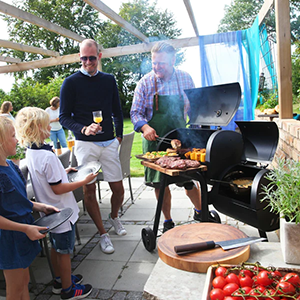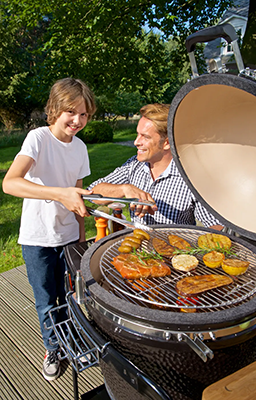Can I barbecue American-style?

Of course, but if you start looking for recipes for barbecue in American cookbooks or on American websites, you run into a number of problems. First, the designations for all kinds of cuts of meat. Second, the fact that in America different sizes are used than we are used to. Third, some ingredients used there are hardly available here, or have the same name but a completely different composition. And finally, fourth, people usually use degrees Fahrenheit instead of degrees Celsius.

Designations for meat
Sometimes an American piece of meat has a name that untranslated is (has become) also common in the Netherlands, such as spare ribs, ribeye and T-bone. In other cases there is a perfect translation, think of pork chops that we call chops. Just as often there is no word available in Dutch that covers the load, such as for the American brisket, or the translation turns out to yield a substantially different cut of meat after all. The confusion is because American butchers use a different method of slaughter than their Dutch and Belgian counterparts.
Part of the problem can be solved by simply taking a piece of meat that is close. To help you with that, a glossary of American names and their Dutch counterparts is included elsewhere in this blog (click here). Nevertheless, if you still prefer the original “cut,” have a chat with your butcher or, perhaps even easier, order your meat online. There are several web shops that specialize in selling American meat. Orders are shipped via refrigerated transport in special insulated boxes with cool-packs and take less than 12 hours to arrive.

Sizes
Americans work with measures of capacity such as cups and(table c.q. tea) spoons. You can’t translate those with cups and spoons. The easiest way to solve that is to buy a set of American measuring cups/spoons. Spend a few Euros more for a good quality set. With the cheapest ones, you will notice the print fading after only a few washes. You can also use your computer’s calculator, or use a conversion website, but that is a bit cumbersome while preparing. Click here to see a page on this blog with tables of conversion examples.
Product differences
If an American recipe states that you should use a certain amount of mustard, then without further indication, it means (yellow) American mustard, which is a weak decoction of what we call mustard. Whether it tastes good or not is irrelevant, but the fact that your dish will have a different taste is. You run the same risk sometimes if you translate a bit too literally. For example, a green pepper is not a green pepper, but a green bell pepper. Peppers are called chilis in America, and they are available there in a dizzying variety, whether fresh, dried or powdered. If you are going to make chili con carne, for example, you will be faced with an array of different (dried and ground) chilies, and they taste different from the stuff from the spice rack that is listed here as chili powder. Common varieties are ancho (dried and ground poblano pepper) and chipotle (dried and ground jalapeño pepper). Another mistake often made is confusing baking soda with baking powder. However, these are different products. If an American recipe lists 1 teaspoon of baking soda, you can replace it with 3 teaspoons of baking powder (but the end result will not be 100% identical).
Unknown products
If you come across American ingredients or products in recipes that cannot be found in the regular supermarket, online web shops often offer a solution. Toko’s are also sometimes willing to help. This is usually not true of fresh vegetables. Since Americans have a reputation for living on fast food and TV dinners, it will come as a surprise to many that the selection of fresh vegetables in American supermarkets is many times more extensive than ours.
Temperatures
In the United States, Fahrenheit is the official temperature scale and not Celsius. The formula for turning degrees Fahrenheit into degrees Celsius is: Temperature in degrees Celsius (°C) = (degrees Fahrenheit (°F) – 32) / 1.8. This page contains examples of commonly used temperatures in Fahrenheit and the Celsius equivalent.







